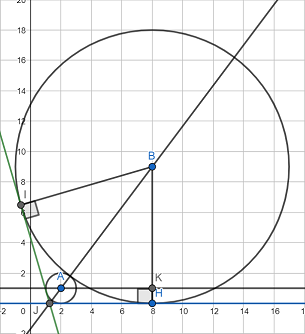Let's first think of the domain of this particular function.
The only portion of this function that can affect the state of the domain is the denominator, so let's investigate it.
If there was a value for x such that \(|x-3|+|x+1|=0\), then a restriction for the domain of this function would exist. Let's see if there are any values for x such that this is true:
| \(|x-3|+|x+1|=0\) | I think the best way to solve this is to think about it logically. You could compute the sign changes, but I think there is a better way.
The absolute value signs always output a nonnegative result. In this equation, we are adding two nonnegative outputs together. There is only one way that the sum of two nonnegative numbers can equal 0. That way is 0+0=0. |
| \(|x-3|=0\\ x-3=0\\ x=3\) | I have determined that the only x-value that makes the first addend, \(|x-3|\), equal to 0 is when x=3. |
| \(|3+1|\stackrel{?}=0\\ 4\stackrel{?}=0\\ \text{false}\) | x=3 is the only candidate that can make this equation equal to 0. The second addend, |x+1|, evaluates to 4 when x=3. However, we determined earlier that |x+1| has to evaluate to 0 in order for solutions to exist. Therefore, there are no solutions, for the real number set at least. |
| \(\text{Domain}: x \in {\rm I\!R}\) | The conclusion from this investigation is that there are no restrictions in the domain. |
The nature of this function is generally one of a cubic function because there are no vertical asymptotes. Dividing by the addition of a sum of nonnegatives numbers does not really affect the range.
\(\text{Range}: x \in {\rm I\!R}\)
.I think that this question is fairly difficult. I have added a few extra lines and points to the diagram where I saw fit:

Here are my initial observations in regard to this current diagram:
These initial observations are enough to get me started with this problem. I constructed a parallel line to the x-axis, \(\overleftrightarrow{AK}\). \(\angle BKA\) is, therefore, a right angle. Point K is located at (8,1) because it acquires the y-coordinate of Point A and the x-coordinate of Point B. \(\triangle BKA\) is a right triangle, and it is possible to find \(\tan(m\angle KAB)\).
\(\tan m\angle KAB=\frac{9-1}{8-2}=\frac{8}{6}=\frac{4}{3}\). Notice how 4/3 is also the slope of \(\overleftrightarrow{AB}\). The actual measure of the angle is not really important.
Because \(\overleftrightarrow{AK}||\overleftrightarrow{JH}\), \(\angle HJB\cong\angle KAB\). By extension, \(m\angle HJB=m\angle KAB\). This also means that \(\tan m\angle HJB=\tan m\angle KAB=\frac{4}{3}\).
Because two tangent lines of a circle intersect at an external point, J, \(\angle IJB\cong\angle HJB\). Using the same reasoning as before, \(\tan m\angle IJB=\tan m\angle HJB=\frac{4}{3}\). \(m\angle IJH=m\angle IJB+m\angle HJB=m\angle HJB+m\angle HJB=2m\angle HJB\)
Both tangent lines meet at an angle of \(2m\angle HJB\). Just like finding \(\tan m\angle KAB\) yielded the slope, \(\tan 2m\angle HJB\) will yield the slope of the desired line, \(\overleftrightarrow{IJ}\).
Luckily, we can utilize the Double-Angles Identities, specifically the \(\tan 2m\angle HJB=\frac{2\tan m\angle HJB}{1-\tan^2 m\angle HJB}\).
| \(\tan 2m\angle HJB=\frac{2\tan m\angle HJB}{1-\tan^2 m\angle HJB};\\ \tan m\angle HJB=\frac{4}{3}\) | This is the Double-Angle Identity for the tangent function. Replace all instances of \(\tan m\angle HJB\) with 4/3. |
| \(\tan 2m\angle HJB=\frac{2*\frac{4}{3}}{1-\left(\frac{4}{3}\right)^2}\\ \tan 2m\angle HJB=\frac{\frac{8}{3}}{\frac{-7}{9}}\\ \tan 2m\angle HJB=\frac{-24}{7} \) | Simplify. The result is the slope of the line \(\overleftrightarrow{IJ}\) . |
| \(y=\frac{-24}{7}x+b\) | This is the equation of the line \(\overleftrightarrow{IJ}\). |
The equation of the circle with the center A is \((x-2)^2+(y-1)^2=1\). Since \(y=\frac{-24}{7}x+b\), substitute that into the equation for the circle:
| \((x-2)^2+(y-1)^2=1;\\ y=\frac{-24}{7}x+b \) | These are the equations we are grappling with. |
| \((x-2)^2+(\frac{-24}{7}x+[b-1])^2=1\) | It is time to expand this monstrosity. |
| \(x^2-4x+4+\left(\frac{-24}{7}x\right)^2+2*\frac{-24}{7}x*(b-1)+(b-1)^2=1\) | |
| \(x^2-\frac{28}{7}x+4+\frac{576}{49}x^2-\frac{48b-48}{7}x+b^2-2b+4=0\) | |
| \(\textcolor{red}{\frac{625}{49}}x^2\textcolor{blue}{-\left(\frac{48b-20}{7}\right)}x+\textcolor{green}{(b^2-2b+4)}=0\\ \textcolor{red}{a}x^2+\textcolor{blue}{b}x+\textcolor{green}{c}=0\) | Notice the parallelism between a quadratic and the current equation. Tangent lines always intersect a circle at only one point, so let's set the discriminant equal to zero to ensure only one solution is possible. |
| \(\Delta=b^2-4ac;\\ \Delta=\left(-\frac{48b-20}{7}\right)^2-4*\frac{625}{49}*(b^2-2b+4)\\ \Delta=\frac{-196b^2+3080b-9600}{49}\) | Set the discriminant equal to zero and solve. |
| \(\frac{-196b^2+3080b-9600}{49}=0\Rightarrow-196b^2+3080b-9600=0\) | Use the quadratic formula here. |
| \(b_1=\frac{30}{7}\text{ or }b_2=\frac{80}{7}\) | Reject b_2 because that is on the other side of the circle. |